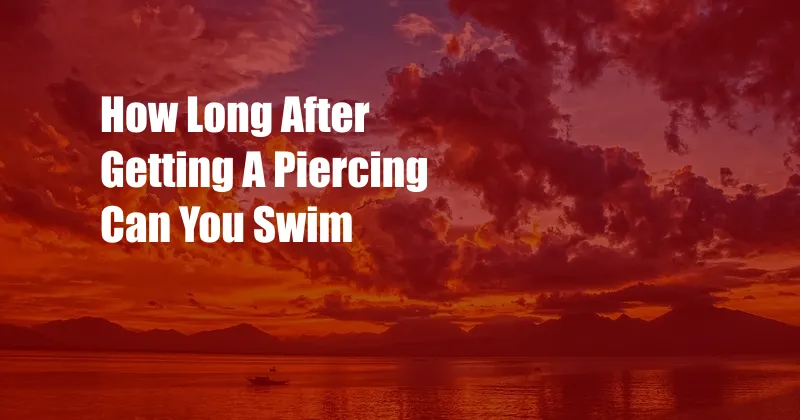
How Long After Getting a Piercing Can You Swim?
As a seasoned piercer with over a decade of experience, I’ve witnessed countless clients eagerly anticipating the moment they can dive into the water after getting a new piercing. While the allure of a refreshing swim is understandable, it’s crucial to prioritize proper healing to avoid complications.
In this comprehensive guide, we’ll delve into the intricacies of piercing aftercare, exploring the optimal timeline for swimming and providing practical tips to ensure your piercing heals beautifully.
Subtlety Beyond the Surface
Before jumping into the specifics, let’s first unravel the intricate interplay between piercings and water. Water, particularly in natural bodies like lakes and oceans, harbors a vast array of microorganisms that can pose risks to a fresh piercing.
During the healing process, your piercing is essentially an open wound. Its delicate state makes it highly susceptible to infection from bacteria and other microbes lurking in water. Moreover, the constant motion and pressure of swimming can irritate the piercing, causing undue discomfort.
Mapping the Healing Timeline
The duration of time you should wait before swimming after getting a piercing varies depending on the location and type of piercing. Generally speaking, here’s a recommended timeline:
- Ear cartilage piercings (helix, conch, tragus): 6-8 weeks
- Earlobe piercings: 6-8 weeks
- Nostril piercings: 8-12 weeks
- Navel piercings: 6-12 months
- Nipple piercings: 6-12 months
- Genital piercings: 6-12 months
li>Oral piercings (tongue, lip): 4-6 weeks
It’s important to note that these are general guidelines. Your piercer may provide specific instructions based on your individual circumstances, so be sure to follow their recommendations closely.
Heed the Signs of Readiness
Beyond the prescribed waiting periods, it’s equally important to pay attention to your piercing’s healing progress. Look for the following signs that indicate it’s ready for a dip:
- Minimal pain and swelling: The piercing should feel comfortable and there should be no significant redness or swelling.
- No discharge: There should be no pus or other discharge coming from the piercing.
- Crust formation: A small amount of crusting around the piercing is normal during healing, but it should not be excessive or foul-smelling.
If you notice any signs of infection, such as persistent pain, swelling, redness, or discharge, do not swim and consult your piercer or a healthcare professional immediately.
Tips for Safe Swimming
Once your piercing has fully healed, you can enjoy swimming without worry. However, to minimize any potential risks, follow these tips:
- Choose clean water: Avoid swimming in polluted or stagnant water.
- Rinse your piercing: Rinse your piercing gently with clean water after swimming to remove any chlorine or other chemicals.
- Avoid excessive soaking: Prolonged exposure to water can soften the piercing, making it more susceptible to movement or infection.
- Keep your jewelry in place: Do not remove your piercing jewelry while swimming, as this can create a pathway for bacteria to enter the piercing.
Expert Advice: Piercing Aftercare
In addition to the general guidelines above, here are some expert tips from a seasoned piercer:
- Clean your piercing regularly: Use a saline solution or piercing aftercare product twice a day to clean the piercing and remove any crust or debris.
- Avoid touching or twisting the piercing: This can irritate the piercing and prolong healing.
- Sleep on a clean pillowcase: Change your pillowcase regularly to prevent bacteria from accumulating on the fabric.
- Be patient: Piercings take time to heal fully. Be patient and follow the aftercare instructions carefully to ensure a successful outcome.
FAQs on Swimming After Piercing
Q: Can I swim in a pool after getting a piercing?
A: It’s generally not recommended to swim in a pool within the first 6-8 weeks after getting a piercing. Chlorine can irritate the piercing and delay healing.
Q: What happens if I swim too soon after getting a piercing?
A: Swimming too soon after a piercing can increase the risk of infection, irritation, and delayed healing.
Q: How can I tell if my piercing is infected?
A: Signs of infection include persistent pain, swelling, redness, discharge, and fever. If you suspect an infection, consult a piercer or healthcare professional immediately.
Q: How long does it take for a piercing to fully heal?
A: Healing times vary depending on the location and type of piercing, but most piercings take 6-12 months to fully heal.
Conclusion
Understanding the relationship between piercings and swimming is crucial for preventing complications and ensuring a successful healing process. By adhering to the recommended waiting periods, paying attention to your piercing’s healing progress, and following proper aftercare practices, you can enjoy swimming without compromising the health of your piercing.
If you have any further questions or concerns, don’t hesitate to consult your piercer or a healthcare professional for personalized advice. Remember, the key to a healthy, beautiful piercing is proper care and patience.
Thank you for reading! I’d love to hear your thoughts on this topic. Are you interested in learning more about piercing aftercare or have any specific questions you’d like me to address?